Fig. 1: Trailer of a documentary about the Grande Hotel which shows the current living conditions (Stoops 2010)
A ‘White elephant’ is a proverb in the English language. It means a possession that is useless or troublesome, expensive to maintain and difficult to dispose of. The origin of the proverb is from the story of the Thai kings of Siam. He gave elephants as a gift to courtiers they disliked, in order to ruin the recipient by the great expense incurred in maintaining the animal (British dictionary). This is in short what you can tell about the Grande Hotel; it is too big, too expensive, built in the wrong period, in the wrong place and it ruined the society around it.
In 1932 was year of the urban plan of Ponte Gêa designed by architects brothers Rebelo de Andrade. It had a place reserved for a hotel and an Olympic swimming pool on one of the most beautiful spots of the plan. This particular spot had a great view of the Indian Ocean, the mouth of the Buzi River and the harbour of Beira. Architect José Porto of the Gabinete de Urbanização Colonial made a concept design but refused it, in order to elaborate it. Perhaps he already had a bad feeling about the manageability of the project. In 1953 the client asked the young architect Fransico de Castro to elaborate the design and be present on the building site, for building management and to design the final detailing. The client was the Companhia de Moçambique. It had the concession to exploit the area of the present provinces of Manica and Sofala by cultivating the country and civilising the inhabitants. The concession ended in 1942 but the Companhia remain to dominate the local economy by owning the local enterprises as a large state holding. One of the main directors was Antonio Arantes e Oliveira. He was a brother of the future Mozambican governor-general and had a close connection with the fascistic dictator Salazar. Arthur Brandão was the first man of the Companhia and had also in a prime position in the regime.
Prime-minister Oliveira Salazar is mainly described as an idealist. His Estado Novo was a late edition of a self-representative colonial power. Beira was dominated by Britain for a long time, duel the Rhodesian dependency to the sea harbour. The rising of the Estado Novo and the ending of the Companhia concession caused a Portuguese wave though the city. The Escudo became the only official currency, the government became dominated by the fascistic regime and the street scope got a metamorphose of new Art Deco and Modern Movement architecture. The prestigious Grande Hotel had to become the main showpiece of success of the Estado Novo in Beira. A luxury accommodation for business partners, influential persons and wealthy tourists which mainly should came from Rhodesia, South Africa and from Portugal with its colonies.
Inauguration
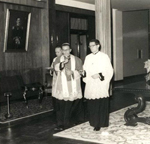 Faith was one of the main distinctions of the Portuguese identity in the
region which was ruled by a strong influence of the reformed or Anglican
church. In 1955 the Grande Hotel was inaugurated by the bishop of Beira,
sir D. Sebastião Soares de Resende during the official opening. The
Hotel was only eight years in business. The Companhia decided to close
the Grande Hotel in 1963. It was not profitable and the costs were too
high to keeps its doors open. The suggested target group of business
people and wealthy tourists never came to Beira. Beira was a popular
tourist destination for the other white middle-income families. They
predominately came from Salisbury, the capital of Rhodesia (today it is
called Harare, the capital of Zimbabwe). Salisbury was at a distance of
one day travelling, 550 km or 9 hours driving. These people could not
afford a holiday in the Grande Hotel. They preferred a beach holiday in
the tourist district Macuti at the lighthouse of Beira, 8 km from the
city centre. The Grande Hotel was only 2 km from the city centre but it
was forbidden to swim at the beach.
Faith was one of the main distinctions of the Portuguese identity in the
region which was ruled by a strong influence of the reformed or Anglican
church. In 1955 the Grande Hotel was inaugurated by the bishop of Beira,
sir D. Sebastião Soares de Resende during the official opening. The
Hotel was only eight years in business. The Companhia decided to close
the Grande Hotel in 1963. It was not profitable and the costs were too
high to keeps its doors open. The suggested target group of business
people and wealthy tourists never came to Beira. Beira was a popular
tourist destination for the other white middle-income families. They
predominately came from Salisbury, the capital of Rhodesia (today it is
called Harare, the capital of Zimbabwe). Salisbury was at a distance of
one day travelling, 550 km or 9 hours driving. These people could not
afford a holiday in the Grande Hotel. They preferred a beach holiday in
the tourist district Macuti at the lighthouse of Beira, 8 km from the
city centre. The Grande Hotel was only 2 km from the city centre but it
was forbidden to swim at the beach.
Architecture
The exterior of the Grande Hotel is inspired by the Art Deco movement.
This was the principal architecture style in Portugal during the 1930s
till 1940s. It was the image of the Estado Novo era of Portugal. Its
elegant geometrical shapes and streamlined repetition was representative
for the modern time and the rapid development. It was a counter reaction
on the neobaroque that was dominant during the previous state. The usage
of materials and technology also contributed to the viewpoint of a
bright future. Most of the Art Deco buildings are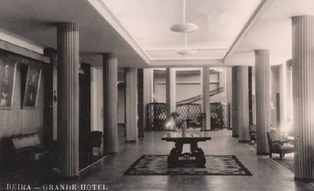 not decorated with
ornaments and patterns; the same was with the exterior of the Grande
Hotel. Not the interior, this was fully decorated in an eclectic style.
Very exclusive materials were used with luxurious refinement, everything
was the best and most modern of its time. This was totally opposed to
the modest Beira of that time. Even for the architect Fransico de Castro
himself. One of De Castro’s other works in Beira is the famous CFM train
station. It is a famous example of the expressionistic Brazilian Modern
Movement in Mozambique. The clients were the ones who had great
influences on the design of the Grande Hotel. Their power made it a
blend of Art Deco, Modern Movement and eclecticism.
not decorated with
ornaments and patterns; the same was with the exterior of the Grande
Hotel. Not the interior, this was fully decorated in an eclectic style.
Very exclusive materials were used with luxurious refinement, everything
was the best and most modern of its time. This was totally opposed to
the modest Beira of that time. Even for the architect Fransico de Castro
himself. One of De Castro’s other works in Beira is the famous CFM train
station. It is a famous example of the expressionistic Brazilian Modern
Movement in Mozambique. The clients were the ones who had great
influences on the design of the Grande Hotel. Their power made it a
blend of Art Deco, Modern Movement and eclecticism.
Casino
Many sources mention that the Grande Hotel also proposed to be a casino (Rolletta 2006; Lança 2010; Anno. 2011). Through investigation and by Lotte Stoops (2011:2) it can be concluded that this statement is not true. The large halls and the spacious corridors make the suggestion of a casino. But the building plans do not refer to special facilities that should refer to a possible casino. Even local architect Fransico Ivo, former student of Fransico de Castro, claimed that De Castro confirmed him that there was no intention for a casino in the Grande Hotel. The suggestion that the absence of the casino was the main failure of the Grande Hotel is hereby not true. The clients of the Grande Hotel where political minded and close to dictator Salazar. Salazar thought that it was morally inappropriate to have gambling places in the African colonies. The casino’s in Lourenço Marques and Costa Bello where forced to close in the early 1930’s. There is no fertile ground for the suggestion of a proposed casino in the Grande Hotel.
During operation
The Grande Hotel was of a totally different class from the rest of Beira.
Beira used to be a workers town where everything relied on the business
the harbour gave. The contribution of the Grande Hotel to the society
was that is was a leisure place. The swimming pool was accessible for
the (white) inhabitants of Beira. In many memories they described the
Grande Hotel as a palace where luxury was abundantly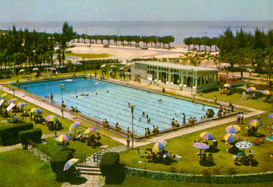 available. As a
child it was possible to enter the kitchen and eat from the finest
chocolates. The two main staircases where for the Beirians also very
impressive and extraordinary.
available. As a
child it was possible to enter the kitchen and eat from the finest
chocolates. The two main staircases where for the Beirians also very
impressive and extraordinary.
The Grande Hotel did not get as many visitors as they suspected. The visitors who came to the Grande Hotel where mostly for political or business reasons. One of the visitors was Hollywood star Kim Novak who came to hunt in the nearby Gorongosa national park. Other visitors where the astronaut team which performed the first Moon landing and the former vice-president of the United States, Dr. Pruzenitz who spent some nights at the Grande Hotel during his term (Stoops 2001).
Reasons of closing
In 1963, after eight years of operation, the Companhia de Moçambique closed the Grande Hotel. The construction costs went above three times the original budget, the hotel never made any profit. The suspected amount of wealthy guests never came. Even with the most incredible rates it would not have been profitable. The workforce was also very large for the amount of guests that it actually received. It needed a lot of maintenance to remain it in the luxury condition. Even in every elevator there was an operator present. In several documents they claimed that the reason the Hotel closed was the refusal of the casino permit by the regime. Actually it was the idealism of the same regime which was the main reason of failure of the Grande Hotel. Any realistic estimation would suggest a failure of the hotel. The white people who lived in the Southern Africa those days couldn’t afford this level of luxury. Internationally Beira was not the first place for wealthy people to spend their holidays. Next to the Grande Hotel, Beira had many accommodations in the high top class. Destinations like the Bazaruto archipelago at Vilanculos, the Mediterranean city life style of the Mozambican capital Lourenço Marques, the South African Krüger national park and the Victoria Falls in Rhodesia where more famous across the world. A cheaper alternative for the Grande Hotel was the Ambassador Hotel. This hotel opened just after the inauguration of the Grande Hotel. Business people preferred this place because it was situated in the Baixa (downtown). Here where most of the offices located. Remarkable is that Arthur Brandão was also the owner of this hotel.
After closing
1963 was not the end of the Grande Hotel. The swimming pool remained open for public. It also remained the main training facility of the Mozambican swimming team delegation for the Olympic games. It even was the only Olympic swimming pool of the colony those days. The hotel itself was only available for large events and conferences. It was only used twice. The first one was for to accommodate the United States congress members. They were on a cruise along the East-African coast. The last time was at the wedding of Petusha Jardim in 1971. She was the daughter of Jorge Jardim, the Mozambique Minister of State those days. He was the so-called governor-general of Mozambique and obtained a high function in the Estado Novo. Traditionally weddings have a lot of guests in the Portuguese culture. For this wedding many important officials from all around the Estado Novo and the neighbouring ‘white laager’ countries were invited. The Grande Hotel was the only respectable place to accommodate this large amount of important guests.
Independence
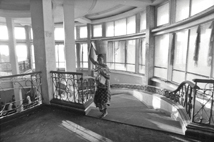 On June 25, 1975 Mozambique became independent. The power was handed
over to the Frelimo, the only represented independence movement in
Mozambique. On that day, the first wedding in Beira under the new
Frelimo regime happened in the Grande Hotel. It should have represented
an optimistic future, bright and with a lot of joy. Later, the bar at
the swimming pool became the office of the Revolutionary Committee. This
organization was responsible for establishing the communist state in
Beira and the province of Sofala. The main hall of the Grande Hotel was
used for party meetings and parties. The basement however became a
prison for opponents against the new ruler.
On June 25, 1975 Mozambique became independent. The power was handed
over to the Frelimo, the only represented independence movement in
Mozambique. On that day, the first wedding in Beira under the new
Frelimo regime happened in the Grande Hotel. It should have represented
an optimistic future, bright and with a lot of joy. Later, the bar at
the swimming pool became the office of the Revolutionary Committee. This
organization was responsible for establishing the communist state in
Beira and the province of Sofala. The main hall of the Grande Hotel was
used for party meetings and parties. The basement however became a
prison for opponents against the new ruler.
In 1977 the civil war broke out in the province of Sofala. The civil war was a fight of capitalism against communism; Renamo against Frelimo, an escalation of the global Cold War. The Rhodesian secret service and the South African Defence Force established Renamo. The apartheid governments were afraid of the new communist regime next to them. They tried by enforcing a civil war to destroy the communist regime of Frelimo. Renamo attacked social and economical targets with brutal guerrilla attacks. The war was not fought between the state and the Renamo, but Frelimo against Renamo. The Grande Hotel was the main political base in this area and started to become more and more a military base of the Frelimo.
By the fall of the apartheid government of Ian Smith in Rhodesia, the ZANU came in power. They renamed the country to Zimbabwe and Robert Mugabe became the president. Through political reasons Zimbabwe was forced to use the Beira corridor to import and export their products. The other routes ran over South African territory which they boycotted for the rival apartheid regime. In 1981 the Zimbabwean Defence Force secured the import and export to the country by establishing a neutral zone of Beira and its corridor. The city became important for refugees for the safety and supply of international aid through the harbour and airport. The Grande Hotel started to become a refugee camp. Most of the refugees came from the rural area. It is said that most refugees arrived during the night. When it was morning, the people where overwhelmed by the ocean view as a phenomenon they never seen before in their life. They wanted to walk to this beautiful surface of waving water that reflected the sunlight in a million different ways, but they fell to their death from the roof terrace. They never realised the height differences. They never experienced buildings with multiply storeys (Stoops 2011:2).
Current
Since 1992 Mozambique experiences a stable peace. The condition of the
Grande Hotel declined. It is overcrowded with a population that
fluctuates around 1,077 inhabitants (Ivo 2008) but it official only has
116 rooms. This causes big social, heath and environmental problems.
Most of the people work in the informal economic sector. This means that
they have an insecure income to afford food on a daily base. Poverty
also caused the Hotel to become even less of a viable living space. One
example is that the water and sewer system is practically completely
removed by the inhabitants to obtain money for food and water. The
maintenance of the collective space is lacking. This has led to garbage
laying everywhere, leaking rain water, open accessible elevator shafts
and inaccessible stairs. Today the Olympic swimming pool contains highly
polluted water.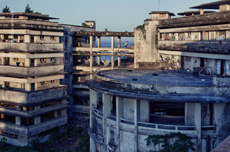
The Grande Hotel is a fascinating building. It reflects each of the historical situations of Mozambique through its occupation. The local municipality wants to intervene in this process but it lacks funds. There is also no investor who is willing to participate in this risk filled project. The idea of the municipality is to relocate the current inhabitants to provide housing in the slum of Chipangara and implode the Grande Hotel. The plot could be redeveloped as a place for commercial activities by the formal neoliberal economic sector. This new sector currently overtakes the city of Beira as what is happening in the capital of Maputo.
Some facts and figures of the Grande Hotel
Address: crossing Ruo Alonso De Paiva and Avenida Sansão Muthemba in Beira, Mozambique
GPS coordinates: 19°50’50”S, 34°50’26”E
Current owner: Grupo Entreposto (SGPS) SA; modern Companhia de Moçambique
Original client: Arthur Brandão, director of the Companhia de Moçambique
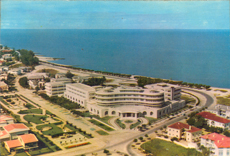 Architect conceptual design: José Porto
Architect conceptual design: José Porto
Architect final design: Francisco de Castro
Date of completion: 1955
Original cost: 90,000 Portuguese escudo’s, estimated: 30,000$00 (Anon. 2011)
Height: 4 stories, 25 metres
Total floor surface: 21,000 m²
Site area: 29,150 m²
FSI: 0,72
Number of hotel rooms: 116
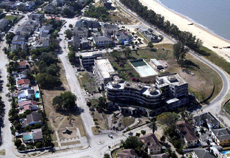 Other hotel functions: Olympic swimming pool, two restaurants, shops,
postal office, bank, cinema, and discothèque
Other hotel functions: Olympic swimming pool, two restaurants, shops,
postal office, bank, cinema, and discothèque
Date of closing: 1963
Usage during 1963-1981: public swimming pool, conference centre, large events, military base
Current number of inhabitants: 1,077 (Ivo 2008)
Number of houses: 211
Other functions: three cinema’s, hairdresser, snackbar, 20 vendors, church, mosque and car workshop
Sources
Anonymous (2011) A Beira e o Grande Hotel da Beira. The Delagoa Bay Blog [accessed 8 February 2012].
Bennett, J. (2005) The story of Beira. Heritage of Zimbabwe, vol. 24, p. 130-139.
Ivo, F. (2008) Estudo preliminar para a desocupação e demolição do Grande Hotel na Beira. Beira: Franciso M. Ivo Arquitecto
Newitt, M. (1994) A History of Mozambique. London: Hurst & Co. Publishers LTD.
Lança, M. (2010) We, the ones from the Grande Hotel da Beira. [accessed 8 February 2012].
Rolletta, P. (2006) O delírio de um Grande Hotel. Savana, September 2006.
Stoops, L. (2011) Grande Hotel [documentary]. St. Antelinks, Belgium: Serendipity Films